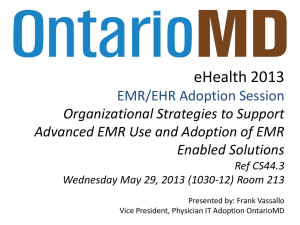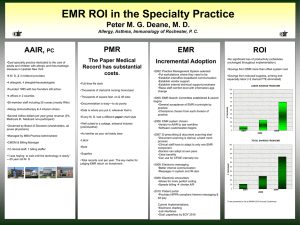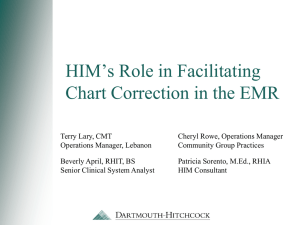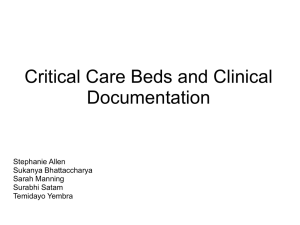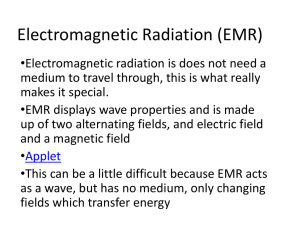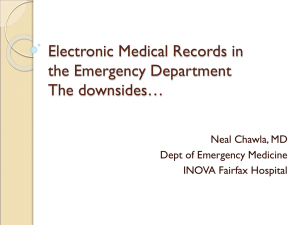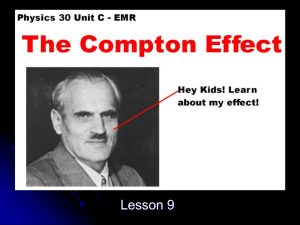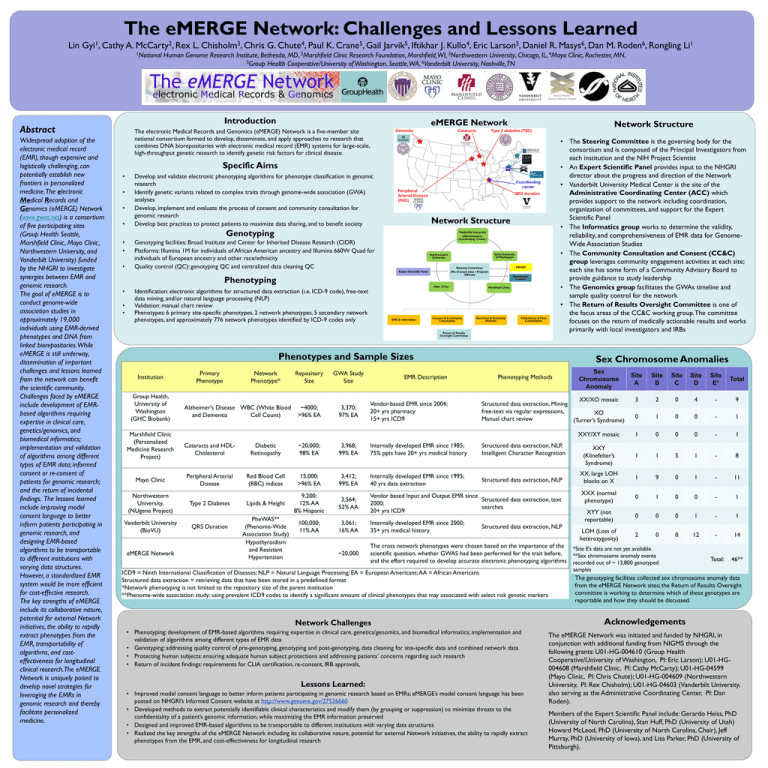
The eMERGE Network: Challenges and Lessons Learned
Lin Gyi1, Cathy A. McCarty2, Rex L. Chisholm3, Chris G. Chute4, Paul K. Crane5, Gail Jarvik5, Iftikhar J. Kullo4, Eric Larson5, Daniel R. Masys6, Dan M. Roden6, Rongling Li1
1National
Introduction
Abstract
Widespread adoption of the
electronic medical record
(EMR), though expensive and
logistically challenging, can
potentially establish new
frontiers in personalized
medicine.The electronic
Medical Records and
Genomics (eMERGE) Network
(www.gwas.net) is a consortium
of five participating sites
(Group Health Seattle,
Marshfield Clinic, Mayo Clinic,
Northwestern University, and
Vanderbilt University) funded
by the NHGRI to investigate
synergies between EMR and
genomic research.
The goal of eMERGE is to
conduct genome-wide
association studies in
approximately 19,000
individuals using EMR-derived
phenotypes and DNA from
linked biorepositories.While
eMERGE is still underway,
dissemination of important
challenges and lessons learned
from the network can benefit
the scientific community.
Challenges faced by eMERGE
include development of EMRbased algorithms requiring
expertise in clinical care,
genetics/genomics, and
biomedical informatics;
implementation and validation
of algorithms among different
types of EMR data; informed
consent or re-consent of
patients for genomic research;
and the return of incidental
findings. The lessons learned
include improving model
consent language to better
inform patients participating in
genomic research, and
designing EMR-based
algorithms to be transportable
to different institutions with
varying data structures.
However, a standardized EMR
system would be more efficient
for cost-effective research.
The key strengths of eMERGE
include its collaborative nature,
potential for external Network
initiatives, the ability to rapidly
extract phenotypes from the
EMR, transportability of
algorithms, and costeffectiveness for longitudinal
clinical research.The eMERGE
Network is uniquely poised to
develop novel strategies for
leveraging the EMRs in
genomic research and thereby
facilitate personalized
medicine.
Human Genome Research Institute, Bethesda, MD, 2Marshfield Clinic Research Foundation, Marshfield,WI, 3Northwestern University, Chicago, IL, 4Mayo Clinic, Rochester, MN,
5Group Health Cooperative/University of Washington, Seattle, WA, 6Vanderbilt University, Nashville, TN
eMERGE Network
Network Structure
The electronic Medical Records and Genomics (eMERGE) Network is a five-member site
national consortium formed to develop, disseminate, and apply approaches to research that
combines DNA biorepositories with electronic medical record (EMR) systems for large-scale,
high-throughput genetic research to identify genetic risk factors for clinical disease.
• The Steering Committee is the governing body for the
consortium and is composed of the Principal Investigators from
each institution and the NIH Project Scientist
• An Expert Scientific Panel provides input to the NHGRI
director about the progress and direction of the Network
• Vanderbilt University Medical Center is the site of the
Administrative Coordinating Center (ACC) which
provides support to the network including coordination,
organization of committees, and support for the Expert
Scientific Panel
• The Informatics group works to determine the validity,
reliability, and comprehensiveness of EMR data for GenomeWide Association Studies
• The Community Consultation and Consent (CC&C)
group leverages community engagement activities at each site;
each site has some form of a Community Advisory Board to
provide guidance to study leadership
• The Genomics group facilitates the GWAs timeline and
sample quality control for the network
• The Return of Results Oversight Committee is one of
the focus areas of the CC&C working group. The committee
focuses on the return of medically actionable results and works
primarily with local investigators and IRBs
Specific Aims
•
•
•
•
Develop and validate electronic phenotyping algorithms for phenotype classification in genomic
research
Identify genetic variants related to complex traits through genome-wide association (GWA)
analyses
Develop, implement and evaluate the process of consent and community consultation for
genomic research
Develop best practices to protect patients to maximize data sharing, and to benefit society
Network Structure
Genotyping
•
•
•
Genotyping facilities: Broad Institute and Center for Inherited Disease Research (CIDR)
Platforms: Illumina 1M for individuals of African American ancestry and lllumina 660W Quad for
individuals of European ancestry and other race/ethnicity
Quality control (QC): genotyping QC and centralized data cleaning QC
Phenotyping
•
•
•
Identification: electronic algorithms for structured data extraction (i.e. ICD-9 code), free-text
data mining, and/or natural language processing (NLP)
Validation: manual chart review
Phenotypes: 6 primary site-specific phenotypes, 2 network phenotypes, 5 secondary network
phenotypes, and approximately 776 network phenotypes identified by ICD-9 codes only
Phenotypes and Sample Sizes
Institution
Group Health,
University of
Washington
(GHC Biobank)
Marshfield Clinic
(Personalized
Medicine Research
Project)
Mayo Clinic
Northwestern
University,
(NUgene Project)
Vanderbilt University
(BioVU)
eMERGE Network
Primary
Phenotype
Network
Phenotype*
Alzheimer's Disease WBC (White Blood
and Dementia
Cell Count)
Repository
Size
~4000;
>96% EA
GWA Study
Size
3,370;
97% EA
EMR Description
Vendor-based EMR since 2004;
20+ yrs pharmacy
15+ yrs ICD9
Sex Chromosome Anomalies
Phenotyping Methods
Sex
Chromosome
Anomaly
Site
A
Site
B
Site
C
Site
D
Site
E*
Total
XX/XO mosaic
3
2
0
4
-
9
0
1
0
0
-
1
XXY/XY mosaic
1
0
0
0
-
1
XXY
(Klinefelter’s
Syndrome)
1
1
5
1
-
8
XX, large LOH
blocks on X
1
9
0
1
-
11
XXX (normal
phenotype)
0
1
0
0
-
1
XYY (not
reportable)
0
0
0
1
-
1
LOH (Loss of
heterozygosity)
2
0
0
12
-
14
Total:
46**
Structured data extraction, Mining
free-text via regular expressions,
XO
Manual chart review
(Turner’s Syndrome)
Cataracts and HDLCholesterol
Diabetic
Retinopathy
~20,000;
98% EA
3,968;
99% EA
Internally developed EMR since 1985;
75% ppts have 20+ yrs medical history
Peripheral Arterial
Disease
Red Blood Cell
(RBC) indices
15,000;
>96% EA
3,412;
99% EA
Internally developed EMR since 1995;
40 yrs data extraction
Lipids & Height
9,200;
12% AA
8% Hispanic
3,564;
52% AA
Vendor based Input and Output EMR since
Structured data extraction, text
2000;
searches
20+ yrs ICD9
100,000;
11% AA
3,061;
16% AA
Internally developed EMR since 2000;
35+ yrs medical history
~20,000
The cross network phenotypes were chosen based on the importance of the *Site E’s data are not yet available.
scientific question, whether GWAS had been performed for the trait before,
**Sex chromosome anomaly events
and the effort required to develop accurate electronic phenotyping algorithms recorded out of ~ 13,800 genotyped
Type 2 Diabetes
QRS Duration
PheWAS**
(Phenome-Wide
Association Study)
Hypothyroidism
and Resistant
Hypertension
Structured data extraction, NLP,
Intelligent Character Recognition
Structured data extraction, NLP
Structured data extraction, NLP
ICD9 = Ninth International Classification of Diseases; NLP = Natural Language Processing; EA = European Americans; AA = African Americans
Structured data extraction = retrieving data that have been stored in a predefined format
*Network phenotyping is not limited to the repository size of the parent institution
**Phenome-wide association study: using prevalent ICD9 codes to identify a significant amount of clinical phenotypes that may associated with select risk genetic markers
Network Challenges
• Phenotyping: development of EMR-based algorithms requiring expertise in clinical care, genetics/genomics, and biomedical informatics; implementation and
validation of algorithms among different types of EMR data
• Genotyping: addressing quality control of pre-genotyping, genotyping and post-genotyping, data cleaning for site-specific data and combined network data
• Protecting human subjects: ensuring adequate human subject protections and addressing patients’ concerns regarding such research
• Return of incident findings: requirements for CLIA certification, re-consent, IRB approvals,
Lessons Learned:
• Improved model consent language to better inform patients participating in genomic research based on EMRs; eMERGE’s model consent language has been
posted on NHGRI’s Informed Consent website at http://www.genome.gov/27526660
• Developed methods to extract potentially identifiable clinical characteristics and modify them (by grouping or suppression) to minimize threats to the
confidentiality of a patient’s genomic information, while maximizing the EMR information preserved
• Designed and improved EMR-based algorithms to be transportable to different institutions with varying data structures
• Realized the key strengths of the eMERGE Network including its collaborative nature, potential for external Network initiatives, the ability to rapidly extract
phenotypes from the EMR, and cost-effectiveness for longitudinal research
samples
The genotyping facilities collected sex chromosome anomaly data
from the eMERGE Network sites; the Return of Results Oversight
committee is working to determine which of these genotypes are
reportable and how they should be discussed.
Acknowledgements
The eMERGE Network was initiated and funded by NHGRI, in
conjunction with additional funding from NIGMS through the
following grants: U01-HG-004610 (Group Health
Cooperative/University of Washington, PI: Eric Larson); U01-HG004608 (Marshfield Clinic, PI: Cathy McCarty); U01-HG-04599
(Mayo Clinic, PI: Chris Chute); U01-HG-004609 (Northwestern
University, PI: Rex Chisholm); U01-HG-04603 (Vanderbilt University,
also serving as the Administrative Coordinating Center, PI: Dan
Roden).
Members of the Expert Scientific Panel include: Gerardo Heiss, PhD
(University of North Carolina), Stan Huff, PhD (University of Utah)
Howard McLeod, PhD (University of North Carolina, Chair), Jeff
Murray, PhD (University of Iowa), and Lisa Parker, PhD (University of
Pittsburgh).

